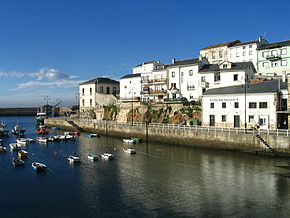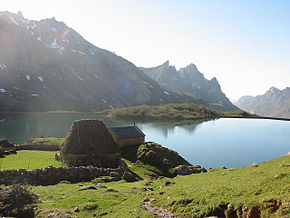| Asturias | |
 | |
Location .svg/250px-Asturias_in_Spain_(including_Canarias).svg.png) | |
Coat of arms and flag | |
| State | Spain |
|---|---|
| Capital | Oviedo |
| Surface | 10,603.57 km² |
| Inhabitants | 1.028.244 (2018) |
| Tourism site | |
| Institutional website | |
Asturias (Principado de Asturias in Castilian) is the name of a region of the Spain.
To know
When to go
Those who want to visit Asturias have to deal with abundant rains, mainly concentrated on the coast although less frequent in summer. The coast is also subject to constant winds which tend to be strong and often unexpected. Several seaside resorts are located in gulfs or deep inlets (rias) sheltered from winds. Asturias enjoys an oceanic climate with exceptionally mild temperatures on the coast in both winter and summer.
Territories and tourist destinations
Urban centers
- 1 Avilés - Second port of Asturias for commercial traffic, Avilés it is renowned for its beaches but above all for the Niemeyer center, a complex inaugurated in 2011 on a project by the famous Brazilian architect, where various artistic and cultural events of international appeal take place.
- 2 Castropol - Ancient village in a picturesque position on a promontory in the middle of the deep estuary (ría de Ribadeo) of the Eo River.
- 3 Covadonga (Cuadonga) - Located in the mountains of the Picos de Europa National Park, Covadonga is a historic town linked to the first successes of the Reconquista Christian. Today it forms the basis for excursions to the two alpine lakes of Enol and Ercina.
- 4 Cudillero - Set in a deep inlet of the Cantabrian Sea, Cudillero is a small, charming fishing port, famous for the Playa del Silencio, one of the most beautiful beaches in Asturias and for the Quinta de Selgas, luxurious residence of 19th century entrepreneurs where you can admire paintings by Goya, el Greco and Luca Giordano, as well as collections of fine tapestries and magnificent gardens, some modeled on the example of those Versailles and others on the Italian and English ones.
- 5 Gijón - An industrial port with oil refineries but with two beaches on either side of the promontory on which its historic center stands.
- 6 Llanes - Picturesque fishing port, Llanes it was once famous for whaling while today it is a popular summer resort thanks to its beaches gathered in small coves that open onto a high and rocky stretch of coast.
- 7 Luarca (Ḷḷuarch) - Tourist port, Luarca it overlooks an amphitheater-shaped bay.
- 8 Oviedo - Regional capital, Oviedo is a pleasant university town with an old town dotted with medieval churches and baroque palaces.
- 9 Ribadesella (Ribeseya) - Seaside resort around the vast Playa de Santa Marina, Ribadesella is famous for the cueva de Tito Bustillo, a cave with rock paintings and for the annual regatta that takes place there in early August (Descenso Internacional del Sella), regularly picked up by Spanish television.
- 10 Salas - Halfway between Oviedo and Luarca, Salas it boasts an interesting historical center and a luxury hotel obtained from the building where he was born Fernando de Valdés, grand inquisitor of Spain of the sixteenth century and founder of the University of Oviedo.
- 11 Tapia de Casariego - Traditional Asturian fishing port, Tapia de Casariego it is on a stretch of rocky coast with several beaches suitable for windsurfing and not for bathing.
- 12 Villaviciosa - Town famous for its Romanesque architecture and with some nearby beaches suitable for bathing.
Other destinations
- 1 Somiedo Natural Park (Parque natural de Somiedo) - Established in 1988, the park was later included in the UNESCO list of biosphere reserves. It extends over high mountain pastures interspersed with woods, especially beech woods, and is accessible from the locality of Pola de Somiedo, where the visitor reception center is located.
- 2 Picos de Europa National Park (Parque nacional de Picos de Europa) - It is the third most visited park in Spain, after that of Tiede a Tenerife and the other of the Sierra of Guadarrama around Madrid. The main accesses are made up of the localities Las Arenas, at the mouth of the valley and the Cares gorges, Cangas de Onís, historic town where the park offices are located e Potes from where you can go up the valley of the river Deva which has its sources in Fuente Dé, a town with cableways.
- From the village of Arriondas it is possible to go up the Sellas river by canoe or kayak. One of the most popular walking tours is the Rue del Cares, a 12 km route that takes place inside a spectacular canyon, nicknamed garganta divina (divine throat).

Hikers in the Cares gorges, Picos de Europa
How to get
By plane
- 1 Asturias Airport ((IATA: OVD). Also known as Oviedo Airport, it is the main regional airport with international flights, only seasonal, managed in 2019 by Volotea (from Venice-Marco Polo e Monk-Franz Josef Strauss) and Vueling (from London-Gatwick). The latter company managed, again in 2019, most of the domestic flights.
- The nearby airport of Santander (190 km from Oviedo) offers a greater choice of flights, even from Italian airports and all managed by Ryanair. Once you have landed you can get on one of the frequent bus lines ALSA that serve the stopover but reservations are required.





_05.jpg/326px-Ribadesella_(Asturias)_05.jpg)


